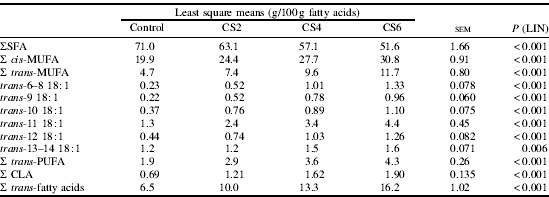Milk and dairy products contribute to about 20% of the average daily intake of trans-fatty acids (TFA) in UK adults(Reference Henderson, Gregory and Irving1). The evidence of their effects on human subjects health are equivocal, but at current intakes and food compositional levels TFA from ruminant products are thought not to be a significant risk factor for CVD. However, there is concern that current strategies to reduce milk SFA will lead to substantial increases in TFA concentrations. Feeding rumen-protected sources of cis-MUFA to dairy cows would minimise the appearance of TFA in milk fat, but research to date has been inconsistent(Reference Chouinard, Girard and Brisson2). The aim of the present study was to measure the effect of feeding incremental amounts of a novel calcium salt (CS) of cis-MUFA on TFA isomer composition of milk fat.
Four multiparous, late-lactation Holstein–Friesian cows were randomly allocated to one of four dietary treatments in a 4×4 Latin Square design with 21 d experimental periods. Treatments were a control diet (control) containing no supplemental fat, or the same basal diet with CS of cis-MUFA (Volac International Ltd.) fed at 20, 40 and 60 g/kg DM (CS2, CS4 and CS6, respectively). Milk composition was analysed during the last 3 d of each experimental period(Reference Givens, Kliem and Humphries3).

P (LIN) represents linear effect. CS2, CS4 and CS6 – treatment diets containing 20, 40 or 60 g/kg DM calcium salts.
Incremental inclusion of CS linearly (P<0.001) decreased milk fat SFA and increased cis-MUFA concentrations. However, there were also significant increases (P<0.001) in all trans-18:1 isomers measured, some trans-PUFA, and total conjugated linoleic acid (CLA), leading to an overall increase in total TFA (16 g/100 g fatty acids for CS6). This indicates CS of cis-MUFA were at least partially metabolised in the rumen and that alternative rumen-protection methods for MUFA are needed to minimise increases in TFA concentrations that accompanied decreased SFA in milk fat.
This research was supported by BBSRC DRINC project BB/1006087/1, and Volac International Ltd., Royston, UK.




